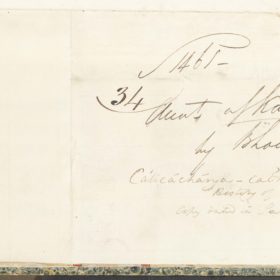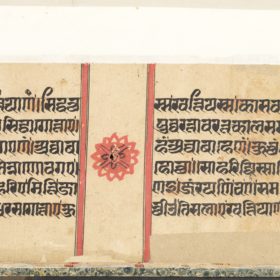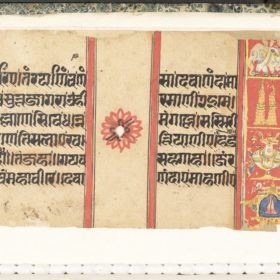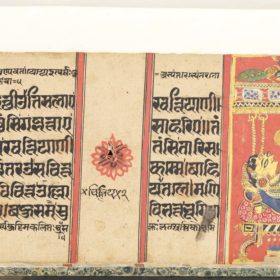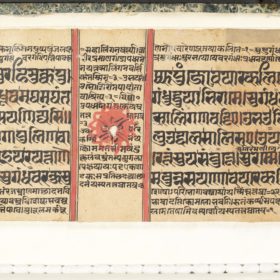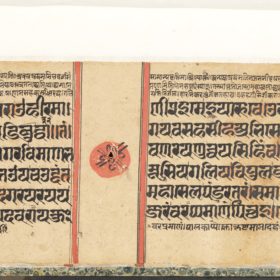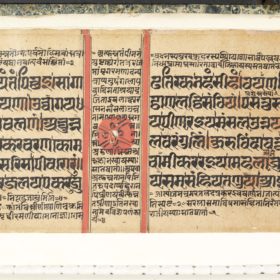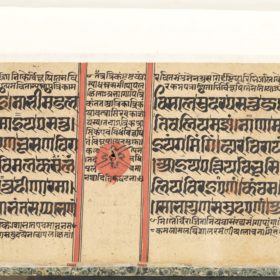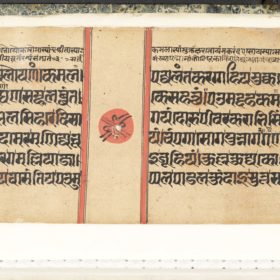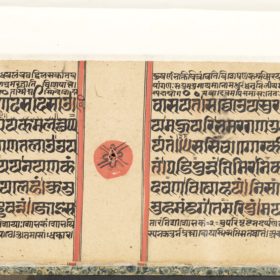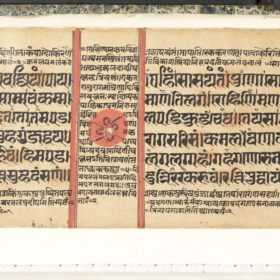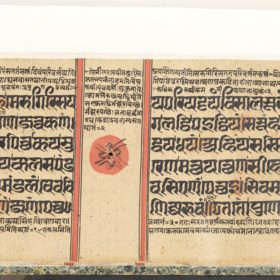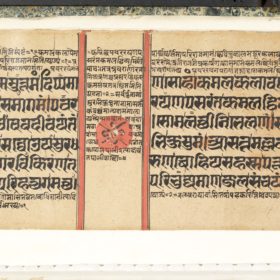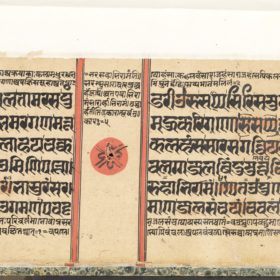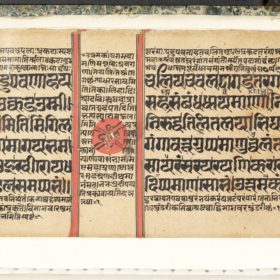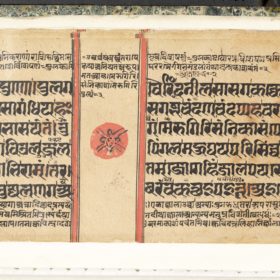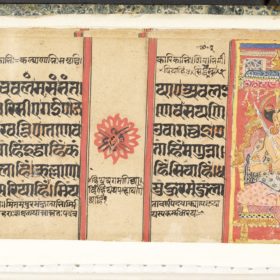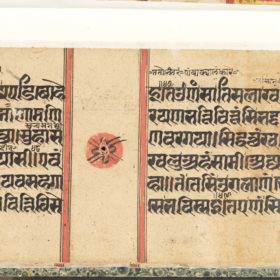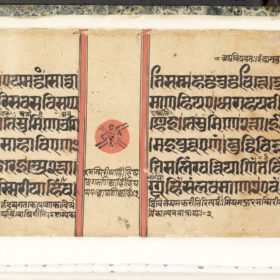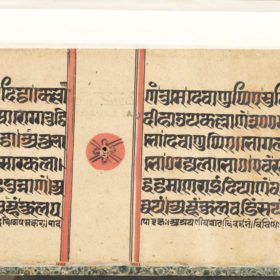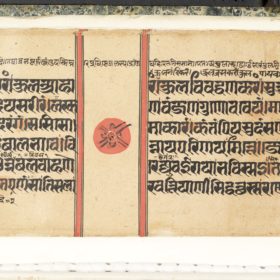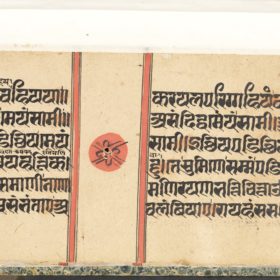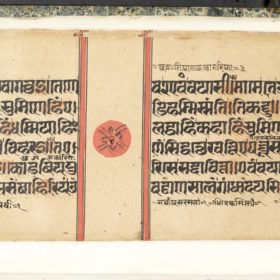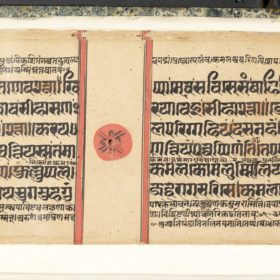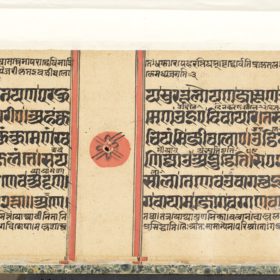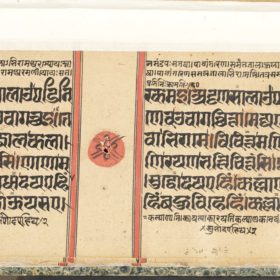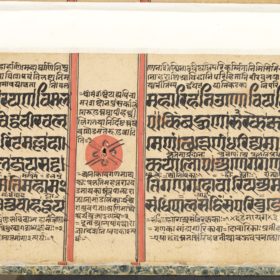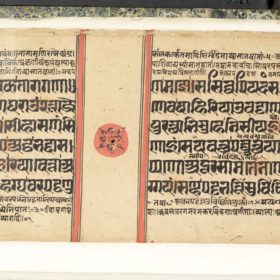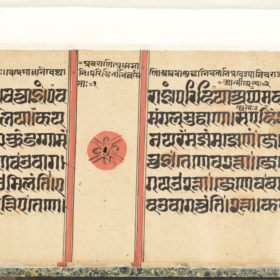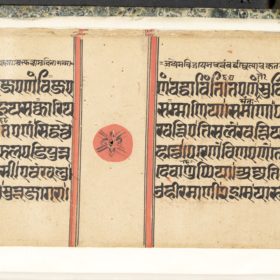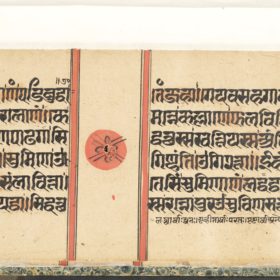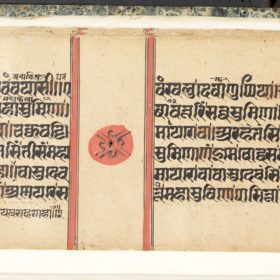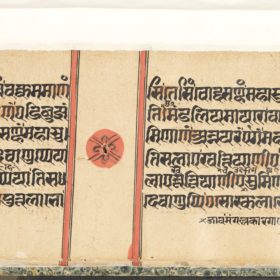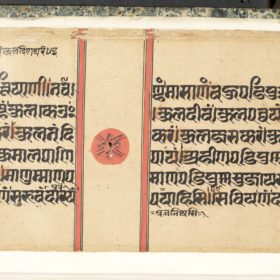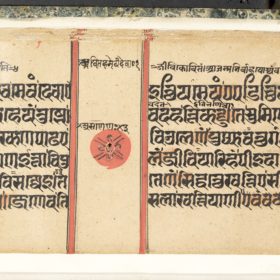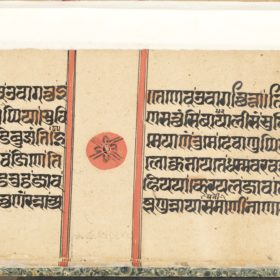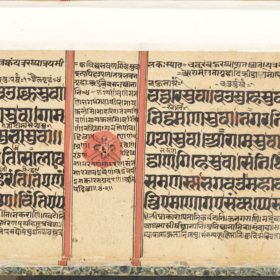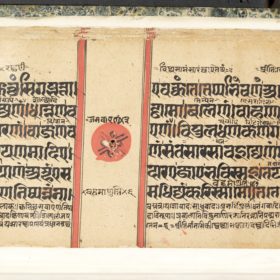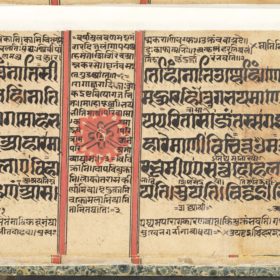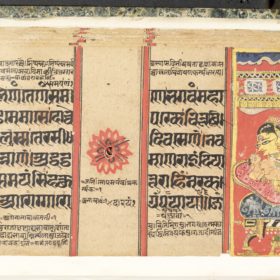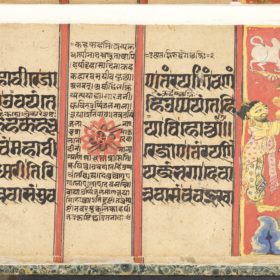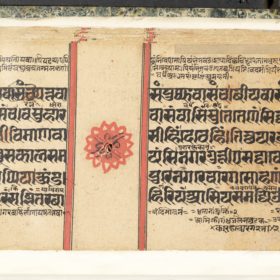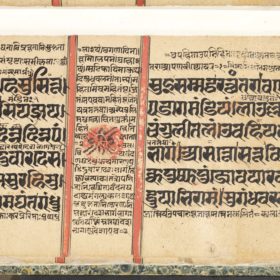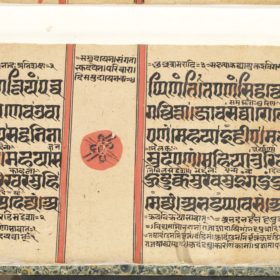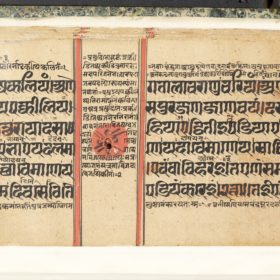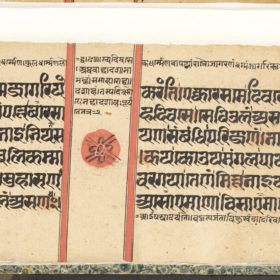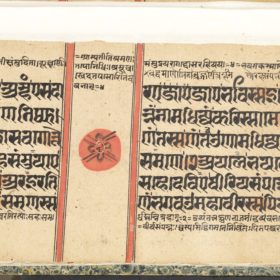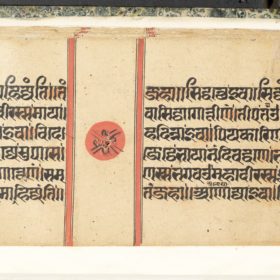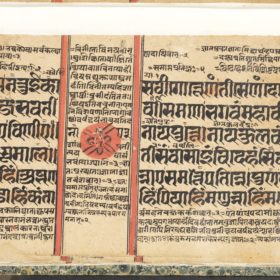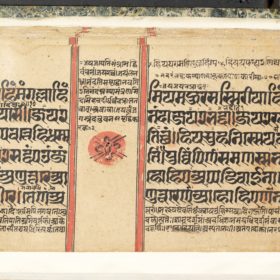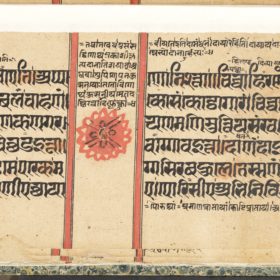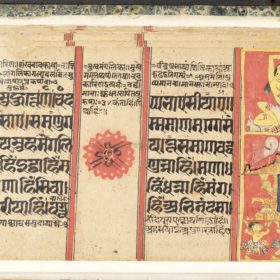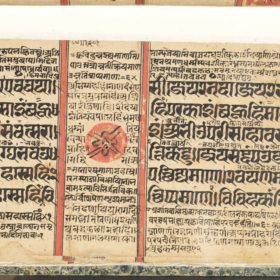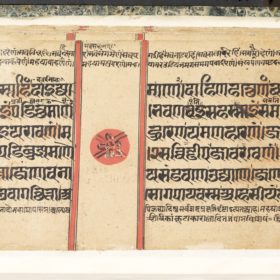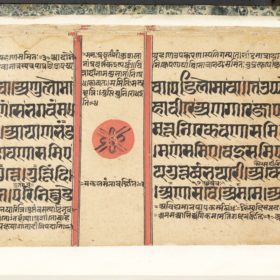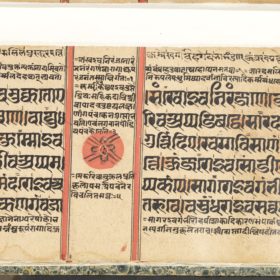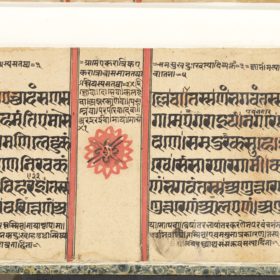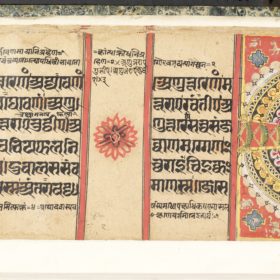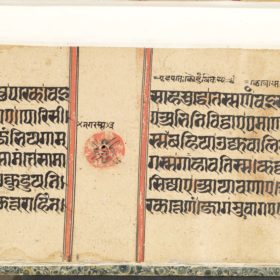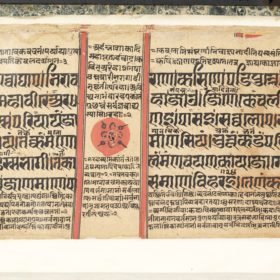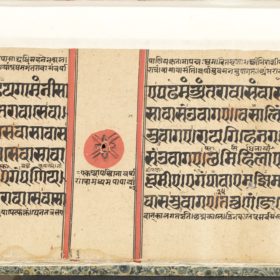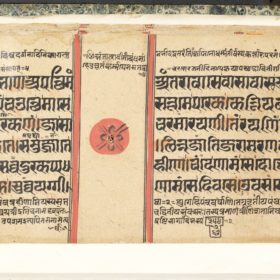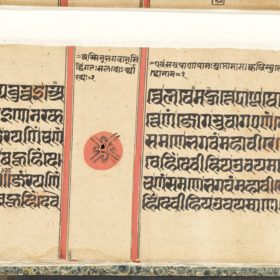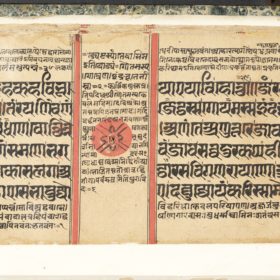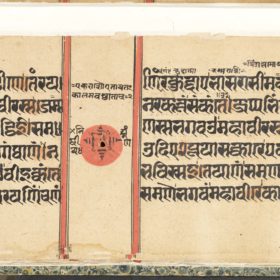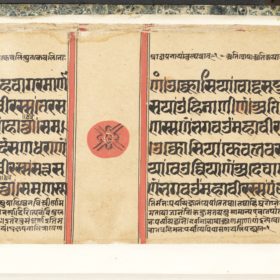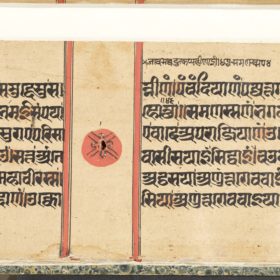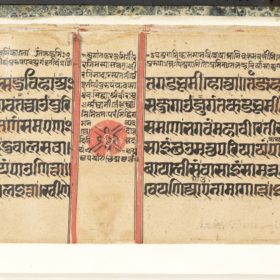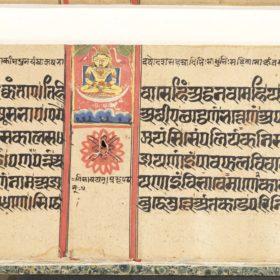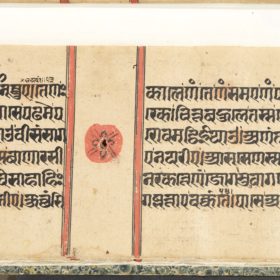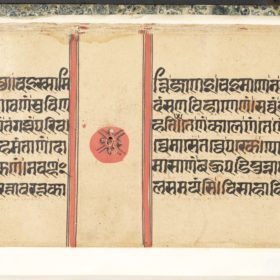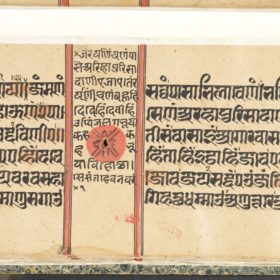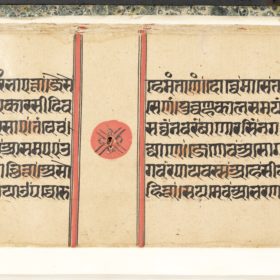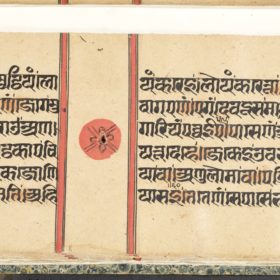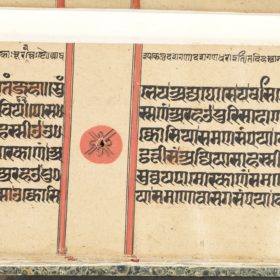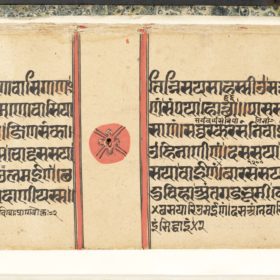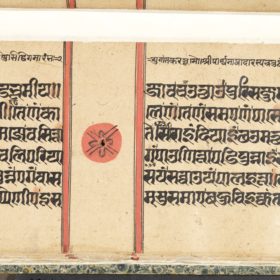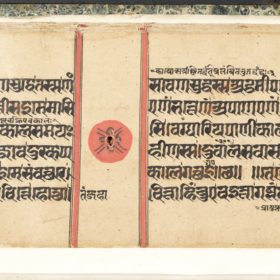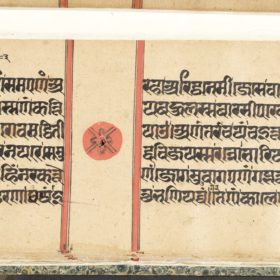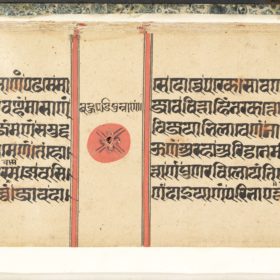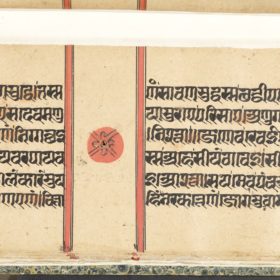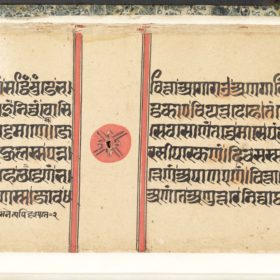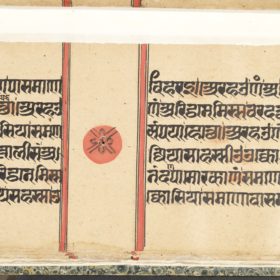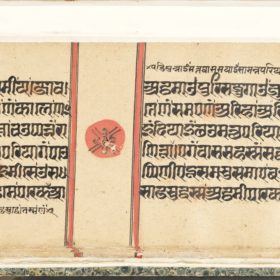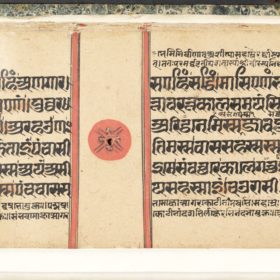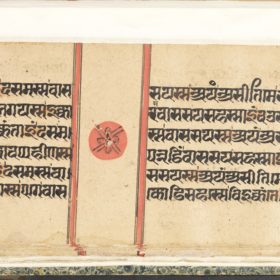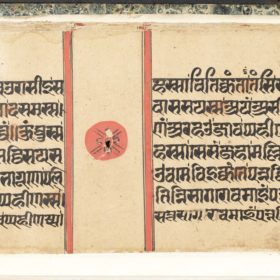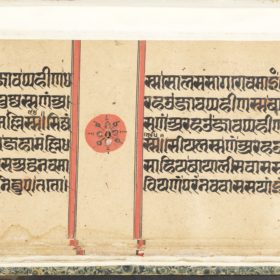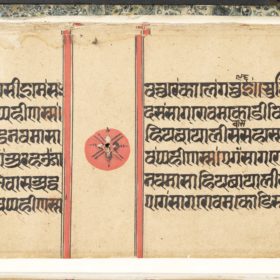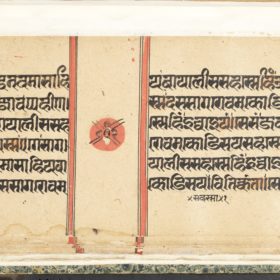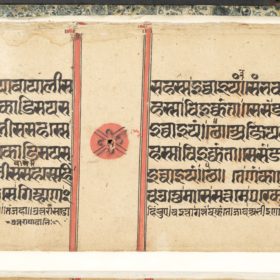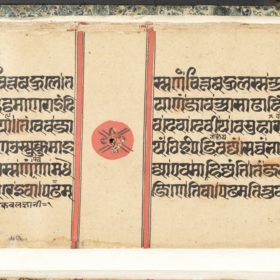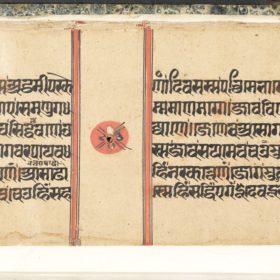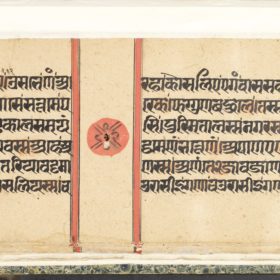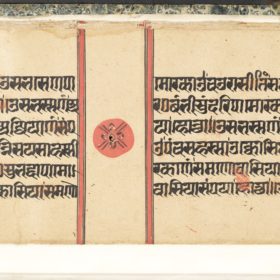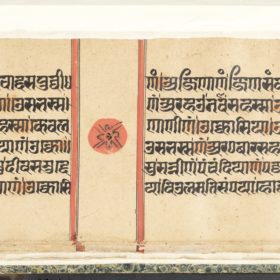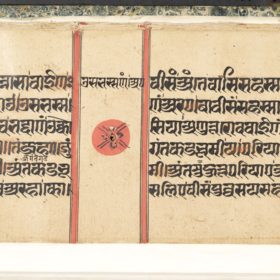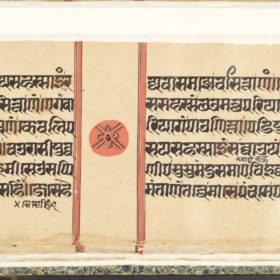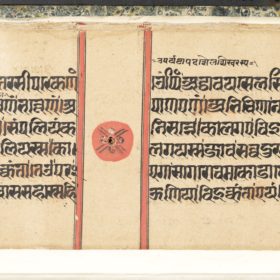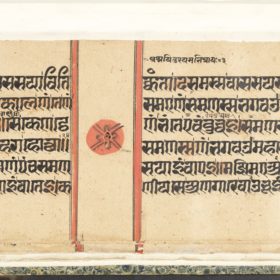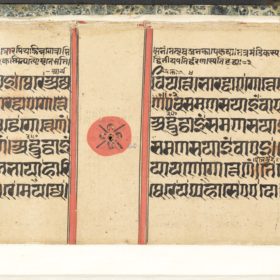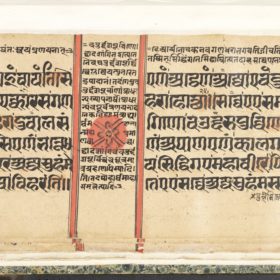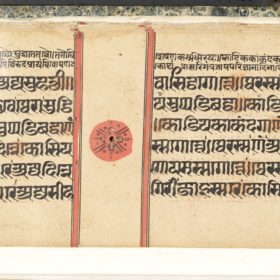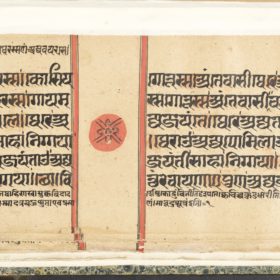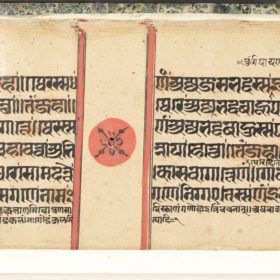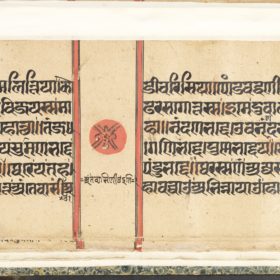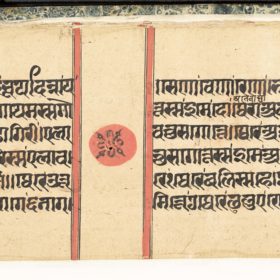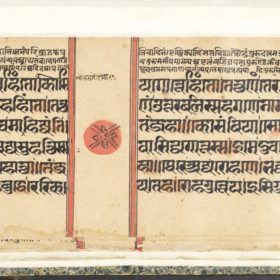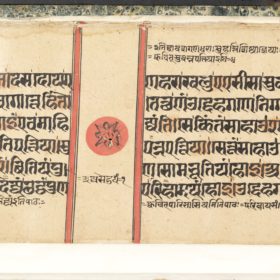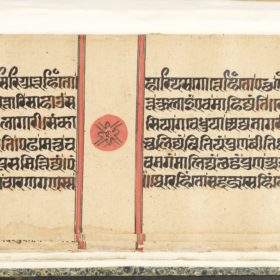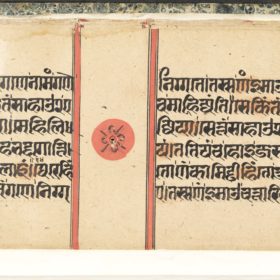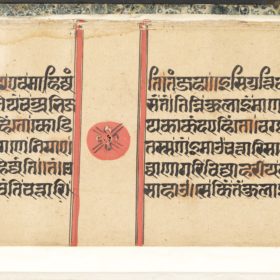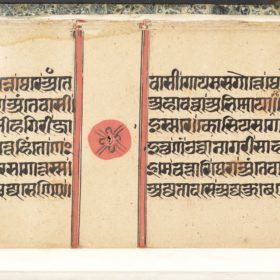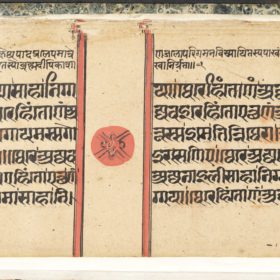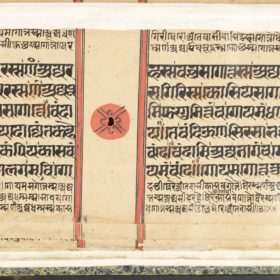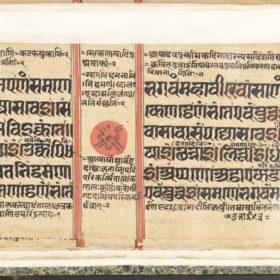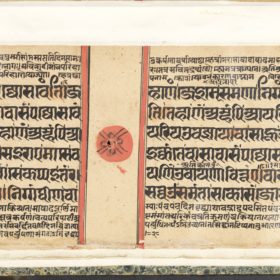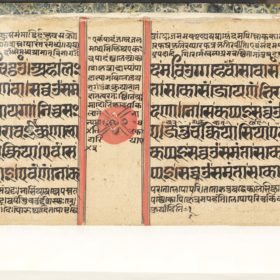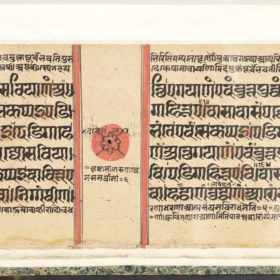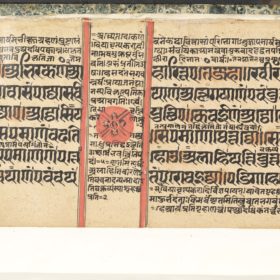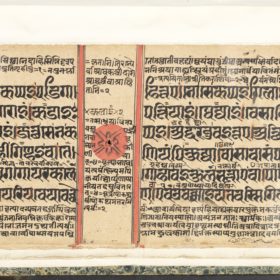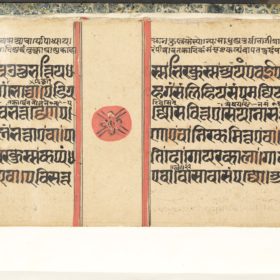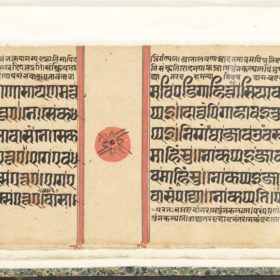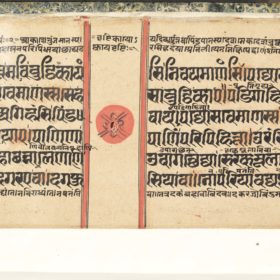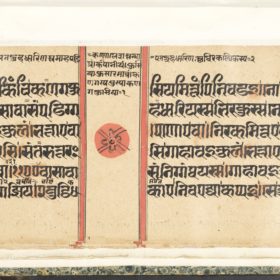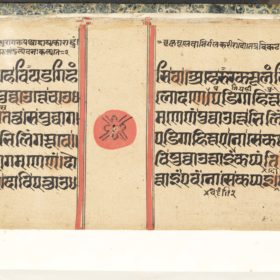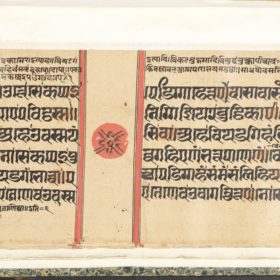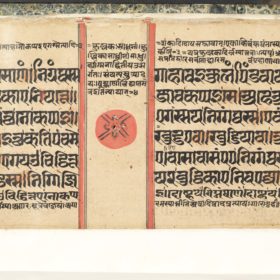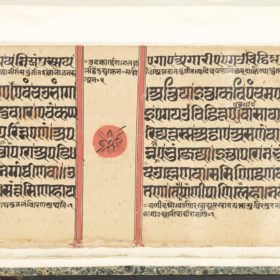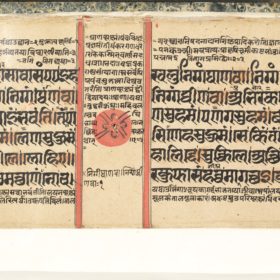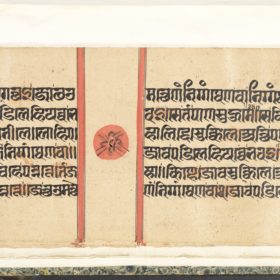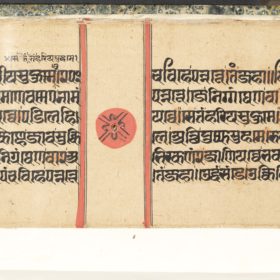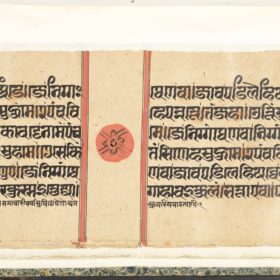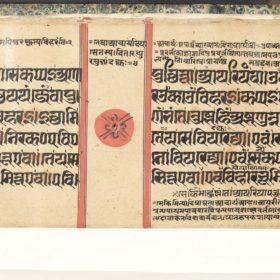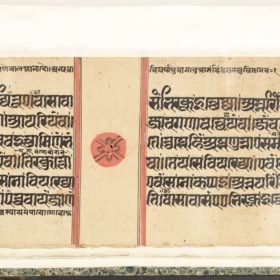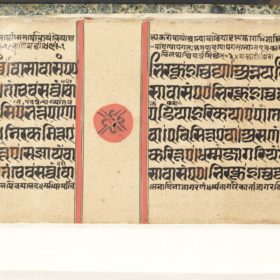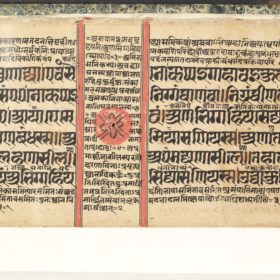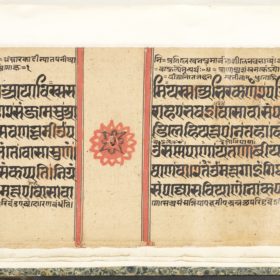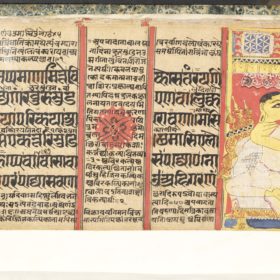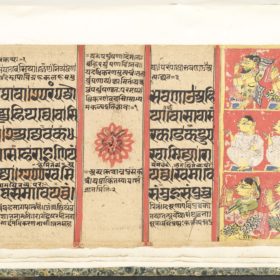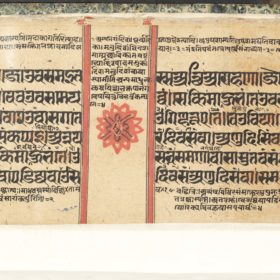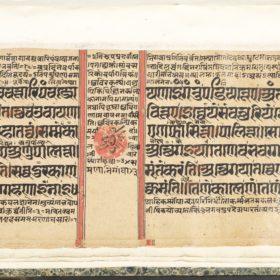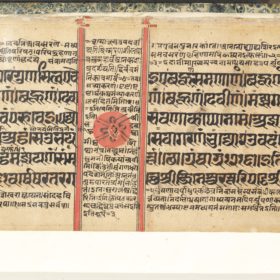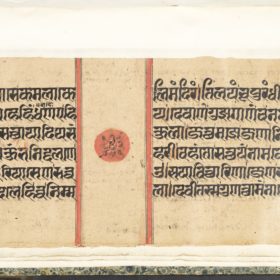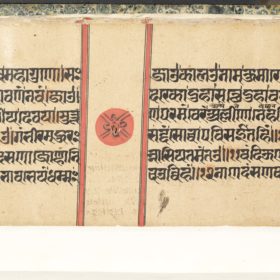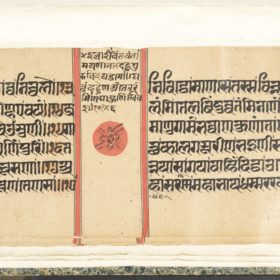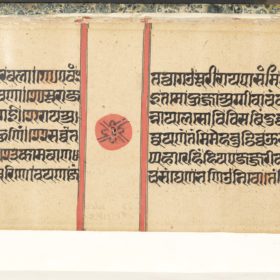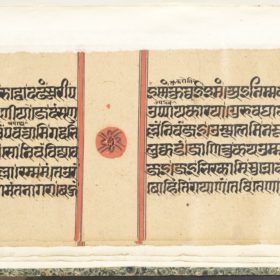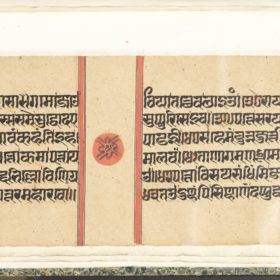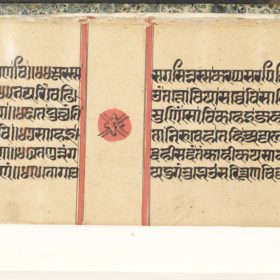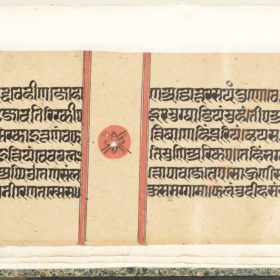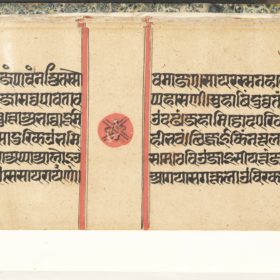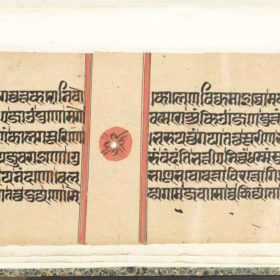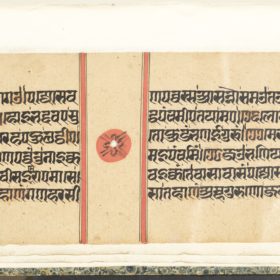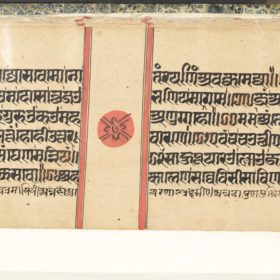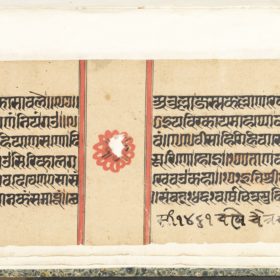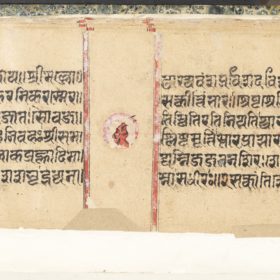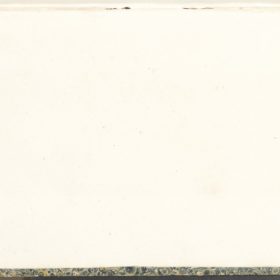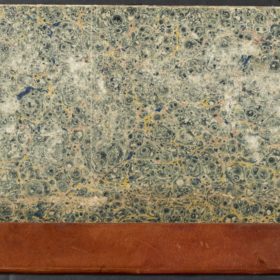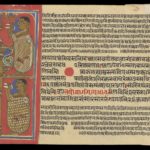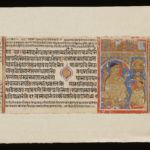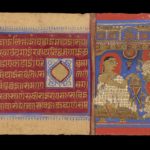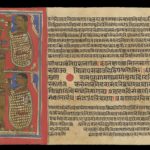
Background
The Kalpa-sūtra is the most frequently illustrated Jain text of the Śvetāmbara sect. It is read and recited by monks in the Śvetāmbara festival of Paryuṣaṇ, which takes place in August to September each year.
The third part of the Kalpa-sūtra – Sāmācārī – deals with particular monastic rules to be followed during the rainy season. The end of the text emphasises the centrality of forgiveness and of showing respect to more senior mendicants. These concepts are shown here in the painting.
The author, or authors, of the Kalpa-sūtra is unknown, although it is attributed to Bhadrabāhu. Manuscripts of the Kalpa-sūtra frequently contain a related text at the end, called the Kālakācārya-kathā. The Story of the Monk Kalaka provides an explanation of the date of the festival of Paryuṣaṇ, in which the Kalpa-sūtra features. The version in this manuscript is by Bhāvadeva-sūri.
Transcription
[On line 6 of folio 101 recto: vāsā-vāsaṃ pajjosavie no kappai niggaṃthāṇa vā niggaṃthīṇa vā paraṃ]
1. pajjosavaṇāo go-loma-ppamāṇa-mitte vi kosa [mistake for kesā] taṃ rayaṇiṃ
2. uvāyaṇāvittae / ajjeṇaṃ khura-muṃḍeṇa vā / lukka-
3. siraeṇa vā / hotavvaṃ siyā pakkhiyā ārovaṇā / māsi-
4. e khūra-muṃḍe / addha-māsie kattari-muṃḍe / cham-māsie lo-
5. e / saṃvatsarie vā / thera-kappe vā / vāsā-vāsaṃ pajjo° no
6. kappai niggaṃthāṇaṃ vā 2 paraṃ pajjosavaṇāo ahigaraṇaṃ
Translation
In the course of Paryuṣaṇā during the monsoon sojourn, a monk or a nun has on the head hair even of the length [similar] to the cow’s hair; then, after the Paryuṣaṇā, he or she is not allowed to keep in that state even for a single night; It is necessary for a noble monk to have his head cleaned by a razor or by a tonsure. Daily tending, fortnightly scissoring, monthly razoring, and tonsure in six months or a year – such are the prescriptions of the senior monks. Having practised paryuṣaṇā during the monsoon sojourn, a monk or a nun [should not use] harsh words after the paryucṣaṇā.
Lalwani’s translation 1979: 180–181, with changes
Glossary
Description
The large figure of a monk sits on a raised seat under a canopy, facing a smaller ascetic. They are in characteristic Śvetāmbara robes. They each hold their mouth-cloths in front of them, which signals that they are talking.
Above the smaller monk is the sthāpanācārya, symbolising teaching and teachers.
This illustration depicts a senior monk teaching another monk. The teacher's higher rank is shown by his larger size and throne-like seat. The listener is a junior member of the monastic community.
Other visual elements
In many Kalpa-sūtra manuscripts, there is a clear intention to make the manuscript a valuable and remarkable object in itself. Here this is achieved in a rather modest manner. This aim is signalled by the:
- ornamental motif in the central margin
- calligraphic script.
The three red discs along the central horizontal plane are symbolic reminders of the way in which manuscripts were bound at one time. Strings through one or more holes in the paper were used to thread together the loose folios so the reader could turn them over easily. The discs are in the places where the holes would once have been.
This manuscript belongs to a rather early phase of Kalpa-sūtra paper manuscripts, the beginning of the 15th century. This is evidenced by the:
- format of the paper, which is rather narrow
- old system of folio numbering, using 'letter-numerals', which is found here in the left-hand margin showing two letters with a zero between them.
In the system of 'letter-numerals', each number or digit from 1 to 10 is represented by a different letter. The number 20 is represented by a particular letter, which is different from those used for 30, 40 and so on. The number 100 has its own letter, while 200 has another letter, 300 its particular letter and so on up to 400. Numbers with more than one digit, such as 34 or 258, are represented by two or three of these letters placed one above the other. On this page the sign for 100 is placed above a 0 and the sign for 1, meaning 101.
The red disc in the middle of the right-hand margin contains the number 101. This is the folio number. It is again written in smaller script in the bottom corner of the page.
Script
The elaborate script is the Jaina Devanāgarī script, in a form which recalls calligraphy. It is used for writing numerous Indian languages, here for Ardhamāgadhī Prakrit and Sanskrit.
The lines in smaller script above and below the main text and in the margins are explanations in Sanskrit of phrases found in the central part. The two small parallel lines like slanted = after the words are meant to separate the explanations in the margins. The parallel lines around words in the text indicate which words are glossed. This page is fully packed with them.
- Source:
Royal Asiatic Society
- Shelfmark:
Tod MS 34
- Author:
unknown author / Bhavadeva-sūri
- Date of creation:
1404
- Folio number:
101 verso
- Total number of folios:
97 folios, numbered 16 to 112, with 1–15 missing
- Place of creation:
western India
- Language:
Prakrit and Sanskrit
- Medium:
ink and watercolour on paper
- Size:
32.5 x 9.4 cm
- Copyright:
Royal Asiatic Society Images/RAS, London
- Image Copyright:
Description
The large figure of a monk sits on a raised seat under a canopy, facing a smaller ascetic. They are in characteristic Śvetāmbara robes. They each hold their mouth-cloths in front of them, which signals that they are talking.
Above the smaller monk is the sthāpanācārya, symbolising teaching and teachers.
This illustration depicts a senior monk teaching another monk. The teacher’s higher rank is shown by his larger size and throne-like seat. The listener is a junior member of the monastic community.
Other visual elements
In many Kalpa-sūtra manuscripts, there is a clear intention to make the manuscript a valuable and remarkable object in itself. Here this is achieved in a rather modest manner. This aim is signalled by the:
- ornamental motif in the central margin
- calligraphic script.
The three red discs along the central horizontal plane are symbolic reminders of the way in which manuscripts were bound at one time. Strings through one or more holes in the paper were used to thread together the loose folios so the reader could turn them over easily. The discs are in the places where the holes would once have been.
This manuscript belongs to a rather early phase of Kalpa-sūtra paper manuscripts, the beginning of the 15th century. This is evidenced by the:
- format of the paper, which is rather narrow
- old system of folio numbering, using ‘letter-numerals’, which is found here in the left-hand margin showing two letters with a zero between them.
In the system of ‘letter-numerals’, each number or digit from 1 to 10 is represented by a different letter. The number 20 is represented by a particular letter, which is different from those used for 30, 40 and so on. The number 100 has its own letter, while 200 has another letter, 300 its particular letter and so on up to 400. Numbers with more than one digit, such as 34 or 258, are represented by two or three of these letters placed one above the other. On this page the sign for 100 is placed above a 0 and the sign for 1, meaning 101.
The red disc in the middle of the right-hand margin contains the number 101. This is the folio number. It is again written in smaller script in the bottom corner of the page.
Script
The elaborate script is the Jaina Devanāgarī script, in a form which recalls calligraphy. It is used for writing numerous Indian languages, here for Ardhamāgadhī Prakrit and Sanskrit.
The lines in smaller script above and below the main text and in the margins are explanations in Sanskrit of phrases found in the central part. The two small parallel lines like slanted = after the words are meant to separate the explanations in the margins. The parallel lines around words in the text indicate which words are glossed. This page is fully packed with them.





























































































